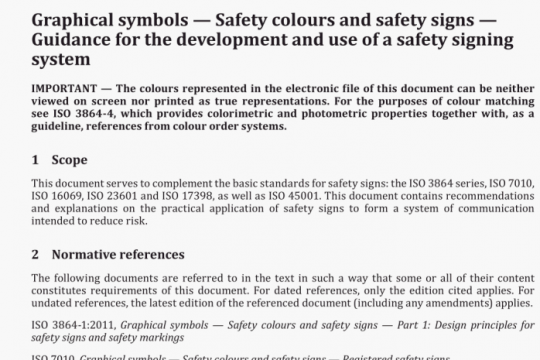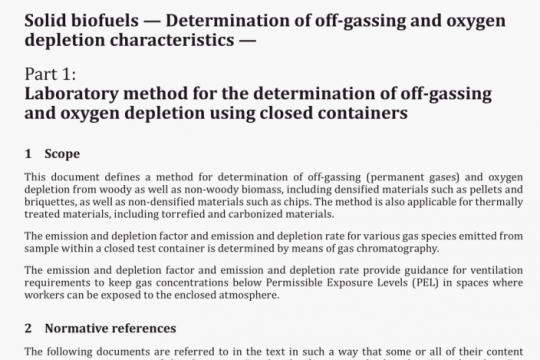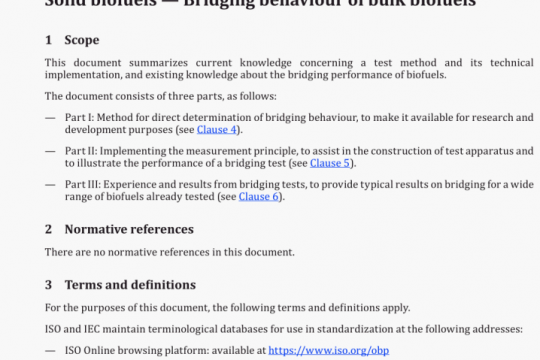ISO 1247-2 pdf free download
ISO 1247-2-2021 pdf free download.Aluminium pigments for paints – Part 2: Vacuum metallized aluminium pigments.
This document specifies the requirements and corresponding test methods for vacuum metallized aluminium pigments (VMP) suitable for use in paints and printing ink industries.
2 Normative references
The following documents are referred to in the text in such a way that some or all of their content constitutes requirements of this document. For dated references, only the edition cited applies. For undated references, the latest edition of the referenced document (including any amendments) applies.
ISO 1247-1:202 1, Aluminium pigments for paints — Part 1: General aluminium pigments
ISO 13320, Particle size analysis — Laser diffraction methods
ISO 15528, Paints, varnishes and raw materials for paints and varnishes — Sampling
150 18451-1, Pigments, dyestuffs and extenders — Terminology — Part 1: General terms
ISO 18451-2, Pigments, dyestuffs and extenders — Terminology — Part 2: Classification of colouring
materials according to colouristic and chemical aspects
3 Terms and definitions
For the purposes of this document, the terms and definitions given in ISO 18451-1, ISO 18451-2 and the following apply.
ISO and IEC maintain terminology databases for use in standardization at the following addresses:
— ISO Online browsing platform: available at https://www.iso.org/obp
— IEC Electropedia: available at http://www.electropedia.org/
3.1 vacuum metallized aluminium pigment VMP
pigment produced in a vacuum metallizing process and subsequent sizing of the vacuum aluminized foils
Note I to entry: Vacuum metallizing process is also referred to as physical vapour deposition process (PVD).
Note 2 to entry: The pigments have non-leafing characteristics, the surface may be untreated or treated by
technical processing including conversion into leafing characteristics.
4 Requirements and test methods
The material shall have the characteristics given in the appropriate column of Table 1.
6.3 Procedure
6.3.1 Test portion
Weigh 10 g of the sample, to the nearest 0,1 g, in the 400 ml beaker (6.2.2).
If it is required by agreement between the interested parties to determine the residue on a sieve of nominal aperture other than 45 I.Im, follow the determination described in 6.3.2. except that the mass of the test portion shall be reduced correspondingly to the smaller nominal apertures of the sieve.
6.3.2 Determination
Half fill three containers (6.2.1) with the liquid (6.1.1). Mix the test portion with 100 ml of the liquid (6.1.1). Add a further 50 ml of the liquid with vigorous stirring. Pour the suspension slowly onto the surface of the test sieve (6.2.3), adjusting the speed of transference so that the majority of the suspension passes through. Wash the residue on the sieve by holding the sieve in the first container at a slight angle to the surface of the liquid and shaking the sieve backwards and forwards so that the screen surface passes just under and just above the level of the mixture. Continue this operation for 1 mm and then repeat the procedure in the second container for about 2 mm.
When it is evident that no more material passes through the sieve, repeat the procedure in the third container with the liquid (6.1.1) for 2 mm to 3 mm. Wash down the sides of the sieve with a small stream of the liquid and collect the residue on one side. Transfer the residue, by washing with a minimum quantity of liquid, to the tared sintered glass filter (6.2.4) and apply suction.
As soon as filtration is complete and the surface of the residue is apparently dry, place the filter in an oven at 105 °C ± 2 °C and heat at this temperature for 1 h.
Weigh the residue to the nearest 1 mg.
6.4 Expression of results
Calculate the residue on sieve, w, expressed as a percentage mass fraction, using Formula (1):
w=.ix100 (1)
m0
where
m0 is the mass, in grams, of the test portion;ISO 1247-2 pdf download.




